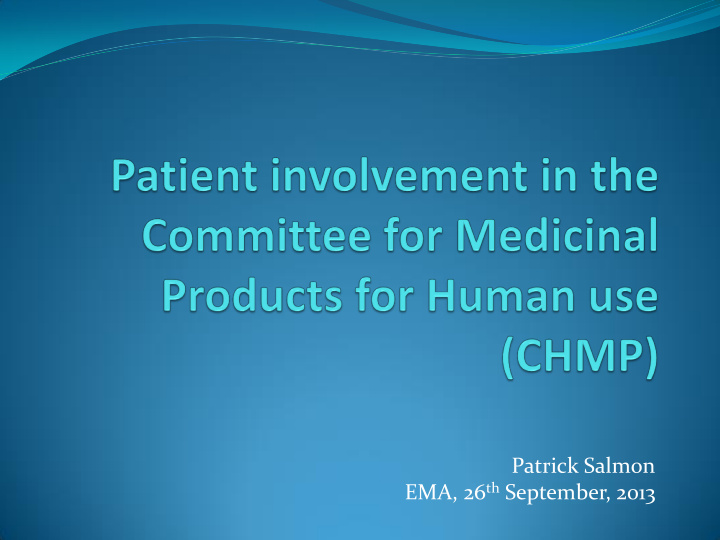



Patrick Salmon EMA, 26 th September, 2013
Patient Involvement Regulator Patient Decision View
Where’s the Patient? Half a century ago, the prevalent attitude of doctors towards their patients was still based on the Hippocratic principle of "Do not tell the patient anything." Not only were patients never told if they had cancer; they were not even supposed to know their own medical details, such as blood pressure. If a patient asked about it as it was being measured, the answer would be that it was "all right."
Where’s the Patient? Likewise, by default, chemists would mark bottles of medicine as "the tablets" or "the mixture." This custom of concealment rebounded on us when we had to deal with casualties: one could not guess which "little white pills" a patient was taking. Digoxin? Phenytoin? Paracetamol? To help with this problem, and to identify anonymous drugs in unmarked containers, drug compendia in those days contained a section of labelled colour illustrations of all pills and capsules in their true size. To get a drug's name on to the container, the prescriber had to specify "NP" for “ nomen proprium ”" BMJ 2006;332:832 (8 April), doi:10.1136/bmj.332.7545.832
Regulators and Patients: CHMP Ad-hoc meetings on product related issues under evaluation Examples include the “meeting of victims’ and patients’ organisations on Thalidomide”; “Ad -hoc expert group meeting on Viracept ”; Tysabri. Written consultations to eligible patients’ organisations CHMP asks for the views of patients and consumers on medicinal products under evaluation through a list of questions Participation in SAG meetings
Regulators and Patients: CHMP Participation in SAWP Patients have been involved in the provision of the Agency’s scientific advice since 2004. Their participation has been limited so far to procedures for protocol assistance. Participation in Guideline preparation (GTWP) Participation as experts in the preparation of guidelines before they were released for external consultation. “ Guideline for follow-up of patients who have been administered gene therapy medicinal products” and the “Guideline on clinical development of medicinal products for treatment of HIV infection”.
Current Role Regulatory Agencies Assess contents of a MA dossier Draw "scientific" conclusions Make decisions based on an overall Benefit- Risk assessment (Article 26, Directive 2001/83)........on behalf of other stakeholders such as patients, doctors, other health care providers etc. A subjective process, influenced by e.g. experience and viewpoint.
Benefit Risk The European Medicines Agency’s opinions are based on balancing the desired effects or ‘ benefits ’ of a medicine against its undesired effects or ‘ risks ’. The Agency can recommend the authorisation of a medicine whose benefits are judged to be greater than its risks. In contrast, a medicine whose risks outweigh its benefits cannot be recommended for marketing. Weighing up the benefits and risks of a medicine is a complex process, since it involves the evaluation of a large amount of data. In addition, there is always some uncertainty around the actual benefits and risks of a medicine, because they can only be determined by looking at the information that is available at a given point in time.
Benefit Risk and Assessment
Examples of When we use Experts Pre-authorisation Difficult applications, especially where there is a real or perceived need for the drug Efficacy not clear (small or in doubt, or of questionable clinical relevance or patient benefit) Safety not clear (occurrence or frequency of serious adverse effects) Proposed refusal of MA or on appeal
Examples of When we use Experts Post-authorisation New safety issues having a significant effect on the benefit risk Shortage or lack of supply of important or essential drugs
How we use experts We ask their advice! Try to make use of their expertise and the added value they represent Pose exact and relevant questions During assessment At specific meetings
Patients are Experts! Remember we’re all patients……. Patients have been involved in many applications... and so far, there have been no bad experiences. Only good ones! Patients add specialised information as well as sometimes much needed….
Common Sense (based on experience) ...................................And a Sense of Reality
Recommend
More recommend